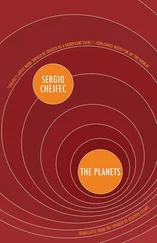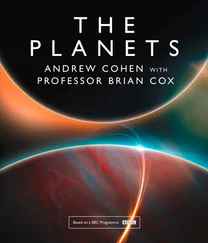Just as they feel the Sun’s attraction more or less keenly, according to their distance, so too do the planets partake of the Sun’s light and heat. Solar energy diminishes in intensity as it radiates through interplanetary space. And so, while parts of Mercury bake at five hundred degrees, Uranus, Neptune and Pluto remain perpetually deep-frozen. Only in the Solar System’s milder middle section, called the habitable zone, have conditions supported the flourishing of ‘great whales, and every living creature that moveth, which the waters brought forth abundantly, after their kind, and every winged fowl after his kind: and … cattle, and creeping thing, and beast of the earth …’
The planets return the favour of the Sun’s light by reflecting its rays, and in this manner they pretend to shine, though they emit no light of their own. The Sun is the Solar System’s sole light-giving body; all the others glow by reflected glory. Even the full Moon that illumines so many lovely Earthly evenings owes its silvery light to Sunbeams bouncing off the dark lunar soil. The Earth shines just as beautifully when viewed from the Moon, and for the same reason.
The play of mirrored light from Venus, close to the Sun and also closest to Earth, makes that planet appear by far the brightest one to our eyes. Jupiter, though much larger, lies many millions of miles beyond, and therefore pales in comparison in our night sky. The even further worlds of Uranus and Neptune, immense as they are, catch and toss back so little light that Uranus can only occasionally be discerned (as a mere point of light) by the naked eye, Neptune never.
Although Pluto, too, is impossible for us to see without a telescope, other objects on the outskirts of the Solar System can and sometimes do flare into sudden visibility. When disturbed by a chance encounter, an ice-rock denizen from Pluto’s depths may be pushed Sunward and transformed from a dull lump into a spectacular comet . Basking in the Sun’s warmth, the frozen body heats up and throws out a trailing tail of castoff gas and icy dust that sparkles with the Sun’s reflection. The brilliance fades and disappears, however, after the comet rounds the Sun and returns to the outer Solar System. *
The visits of comets, long interpreted as signs and wonders, have recently sketched the true extent of the Sun’s domain. By tracing the visible parts of comet paths, and extrapolating the rest, astronomers have shown that numerous comets hail from out beyond Pluto’s neighbourhood, from a second comet reservoir, hundreds of times further away. Despite their unimaginable distance, these bodies still belong to the Sun, still heed the Sun’s gravity, still receive some glimmer of the Sun’s light.
Sunlight, which darts through space at the dazzling speed of 186,000 miles per second, takes ages to emerge from the dense interior of the Sun. Light advances only a few miles per year near the Sun’s core, where the crush of matter repeatedly absorbs it and impedes its escape. Radiating this way, light may journey for a million years before reaching the Sun’s convective zone, there to catch a quick ride up and out on roiling eddies of rising gas. As soon as these eddies release their cargoes of light, they sink back down, to soar again later with more.
The light-emitting, visible surface of the Sun – the photosphere – seethes as though boiling from the constant tumult of energy release. Gas bubbles bursting with light give the photosphere a grainy complexion, marred here and there by pairs of dark, irregularly shaped sunspots, with black centres and grey, graded shading around them like the penumbras of shadows. Sunspots designate areas of intense magnetic activity on the Sun, and their darkness bespeaks their relative coolness of about 4000°K, compared to neighbouring areas at nearly 6000. *The level of solar activity rises and falls in cycles averaging eleven years, and sunspots mingle, morph, and multiply according to this same schedule. Their number and distribution vary like famine and plenty, from no spots at ‘solar minimum’, or just a few spots dotting the Sun’s high latitudes, to ‘solar maximum’ five to six years later, when hundreds of them crowd closer to the equator. Although sunspots seem to gather and scud like clouds across the photosphere, really it is the Sun’s rotation that carries them around.
The Sun rotates on its axis approximately once a month, in a continuation of the spinning motion it was born in. Being an enormous ball of gas, the Sun spins complexly, in layers of various speeds. The core and its immediate surroundings turn at one rate, as a solid body. The overlying zone spins faster, and above that, the visible photosphere whirls around at several different rates, more quickly at the Sun’s equator than near its poles. These combined, contrary motions whip the Sun into a fury, with consequences felt clear across the Solar System.
The ‘solar wind’, a hot exhalation of charged particles (reminiscent of the ‘wind from God’), blows out from the turbulent Sun and keeps up a constant barrage on the planets. Were it not for the protective envelope of Earth’s magnetic field, which deflects most of the solar wind, humankind could not withstand the onslaught. From time to time, especially during solar maximum, the steady solar wind is augmented by sudden blasts of higher-energy particles from solar flares on the Sun’s surface, or by gargantuan blobs of ejected solar gas. Such outbursts can disable our communications satellites and disrupt power grids, causing blackouts. In milder doses, particles of solar wind trickle into the upper atmosphere near the North and South Poles, initiating cascades of electrical charge that draw curtains of coloured lights across the sky – the so-called Northern and Southern Lights. Other planets also sprout colourful auroras in response to the solar wind, which billows on past Pluto all the way to the heliopause – the undiscovered boundary where the Sun’s influence ends.
From Earth, we see the Sun as a blazing circle in the sky, brighter but no bigger than the circumference of the full Moon. The ‘two great lights’, as the Sun and Moon are described in Genesis, make a matched pair. For although the Moon measures only one four-hundredth the Sun’s million-mile diameter, it nevertheless lies four hundred times closer to Earth. This uncanny coincidence of size and distance enables the puny Moon to block out the Sun whenever the two bodies converge on their shared path across Earth’s sky.
Approximately once every two years, some narrow swath of Earth – as often as not a godforsaken, all but inaccessible place – is blessed with a total solar eclipse. There, dusk falls and dawn breaks twice on the same day, and the stars come out with the Sun still overhead. Temperatures may drop ten or fifteen degrees at a stroke, allowing even the most jaded observer to sense the bizarre disorientation that birds and animals share as they hasten to their nests or burrows through the sudden midday darkness.
No total eclipse can last much longer than seven minutes, because of Earth’s persistent turning on its axis and the Moon’s unwavering march along its orbit. But totality of the briefest duration affords sufficient reason for scientific expeditions and curious individuals to travel halfway around the world, even if they have seen one or more eclipses before.
At totality, when the Moon is a pool of soot hiding the bright solar sphere, and the sky deepens to a crepuscular blue, the Sun’s magnificent corona, normally invisible, flashes into view. Pearl and platinum-coloured streamers of coronal gas surround the vanished Sun like a jagged halo. Long red ribbons of electrified hydrogen leap from behind the black Moon and dance in the shimmering corona. All these rare, incredible sights offer themselves to the naked eye, as totality provides the only safe time to gaze at the omnipotent Sun without fear of requital in blindness.
Читать дальше












